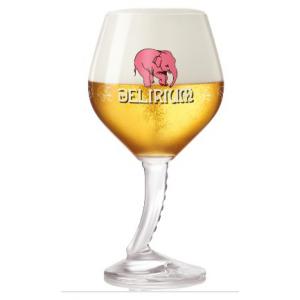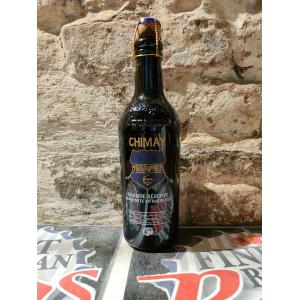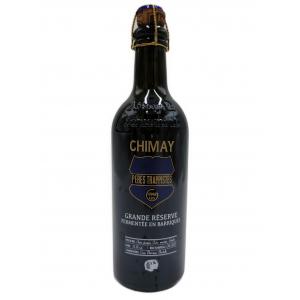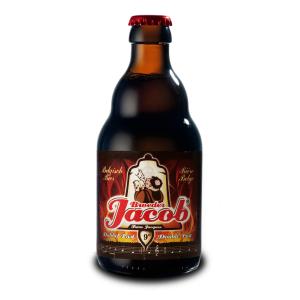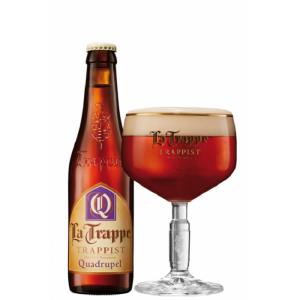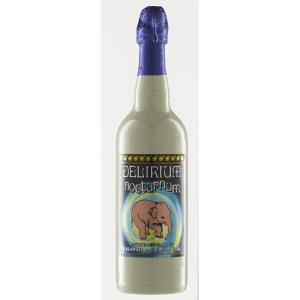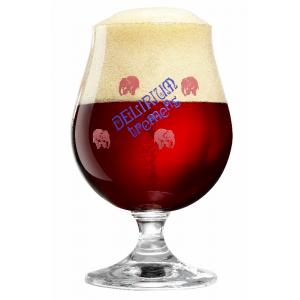| In stock | Alcohol | Packaging |
£
6.00
excl. VAT
|
| Yes | 8,5% | 75cl |
Initially, a very good mouthfeel of alcohol and softness. This is followed by an increasing bitterness, partially from the hop, but also from the roasted malt and chocolate malt. Towards the end a nice balance between bitterness, sour and sweet. A complex entity of caramel malt, fruit, spices and the sweetness of the alcohol.
![]() 94/100 => Read the comments and rating on Ratebeer
94/100 => Read the comments and rating on Ratebeer
1654Ever since 1654 there has undoubtedly been some kind of brewing activity in the "Appelhoek" in Melle.Ever since 1654 there has undoubtedly been some kind of brewing activity in the "Appelhoek" in Melle.1902In 1902, Léon Huyghe settled in MelleIn 1902, Léon Huyghe settled in Melle1906Barely four years later, in 1906, he bought the brewery, which he named "Brouwerij-Mouterij den Appel". During the First World War, several breweries got into trouble, and after the war the brewing-coppers, which the occupying forces had claimed, had to be replaced as quickly as possible. (Nowadays, one of those coppers hangs above the bar in the museum as a kind of decorating dome).Barely four years later, in 1906, he bought the brewery, which he named "Brouwerij-Mouterij den Appel". During the First World War, several breweries got into trouble, and after the war the brewing-coppers, which the occupying forces had claimed, had to be replaced as quickly as possible. (Nowadays, one of those coppers hangs above the bar in the museum as a kind of decorating dome).1936In 1936 the construction of a new complex started along the Geraardbergsesteenweg. This building will accommodate the new brewery as of 1939 onwards. The brew room is still the pride of the brewery. In 1938 the name “Den Appel” was replaced by brewery Leon Huyghe Ltd. 1939In 1939, the new buildings along the Geraardsbergsensteenweg were finished. They contain the new brewery-hall, which is still the pride of the brewery.In 1939, the new buildings along the Geraardsbergsensteenweg were finished. They contain the new brewery-hall, which is still the pride of the brewery. 1945It took some trial and error but in 1945 the first fine lager was produced: the “Golden Kenia”, named after a French barley variety. This beer won several prizes: 1964The brewery knew a huge expansion and in 1964 a modern bottle filling line was built. The golden sixties saw the breakthrough of the German Dort-type beers and Brewery Huyghe also developed its own dort beer, named “Eigerbrau”. 1970During the 70s the sales declined and action was needed. The problems were solved thanks to a shift in the sales approach. Apart from the over 300 obligatory pubs where the beer was sold, the brewery no longer was focusing on small beer merchants whose clients were increasingly looking for the bigger brands anyway. Instead, the focus moved to collective entities, such as company restaurants, social service departments, hospitals, schools, railways, etc. where the brewery could also deliver table beers and lemonades next to the lager. 1985When the brewery was radically reformed in 1985, production and company divisions were formed. The restructuring of the company was coupled with considerable financial investment, and the production of traditional pilsen beer was switched to that of high fermentation beers. For the first time, export was considered. On July 5th 1985, the amber beer "Artevelde" was put on the market.When the brewery was radically reformed in 1985, production and company divisions were formed. The restructuring of the company was coupled with considerable financial investment, and the production of traditional pilsen beer was switched to that of high fermentation beers. For the first time, export was considered. On July 5th 1985, the amber beer "Artevelde" was put on the market. The brewery is now producing 13,500 hectoliter. 1987In 1987, the brewery started fermenting beer in the bottle, by producing the " Artevelde grand cru".In 1987, the brewery started fermenting beer in the bottle, by producing the " Artevelde grand cru". 1989On December 26th 1988, the famous "Delirium Tremens" was born. The particular character and the unique taste of "Delirium Tremens" result from the use of three different kinds of yeast. Its very original packing, which resembles cologne ceramics, and the colourful label contribute to its success. The label depicts the different phases of the production of "Delirium Tremens" the "Pink Elephant" was up and ready to conquer the world. To celebrate the bicentennial of the French Revolution in 1989, the topical beer "La Guillotine" was launched. 1990In 1990, "Blanche des Neiges" was created for the demand of the American market.In 1990, "Blanche des Neiges" was created for the demand of the American market. 1992In 1992, the "confrerie of the pink Elephant" was founded. Its task is to promote "Delirium Tremens" and the other beers of Melle. The brewery Huyghe took over the breweries "Campus", "St Idesbald" and "Vielle Villers".In 1992, the "confrerie of the pink Elephant" was founded. Its task is to promote "Delirium Tremens" and the other beers of Melle. The brewery Huyghe took over the breweries "Campus", "St Idesbald" and "Vielle Villers". 1993In 1993, the production of fruit-beers of the "Floris" range was started. It contains, for example, beers made from cherries, raspberries or apples.In 1993, the production of fruit-beers of the "Floris" range was started. It contains, for example, beers made from cherries, raspberries or apples. 1994In February 1994 the family Huyghe acquired the brewery Damy from Olsene. This way the abbey beers of Sint Idesbald (blonde, double, triple) further completed the abbey beer segment of the brewery. 1995The fruit beers based on wheat beer are finally completed: brewery Huyghe – the last remaining brewery in the Ghent region – is launching four new fruit beers at the same time, under the brand name “Floris”. In the years to follow 3 more beers will be added to that range. Next to the Floris wheat beer, there is also Griotte, Fraise, Passion, Honey, Chocolate and Ninkeberry (a mixture of 5 tropical fruits). 1996In order to serve the clients even better a new reception area and a museum are built: the art of brewing in general and the Huyghe brewery family have such a rich history that it would be a shame not to share that with everyone. 1997In 1997, our show-beer "Delirium Tremens" is nominated "best beer in the world". A gold medal during the "world beer championships" in Chicago (1998) confirmed that worldwide recognition. "The name Delirium Tremens speaks for itself. Words simply cannot describe the intricate flavor of this beer. But that won't stop me from trying. The color is golden and the head creamy and light. The first sip warms my throat and belly like an old woodstove does a log cabin. It's lightly hopped and surprisingly malty for such an airy, sunshiny beer. The aftertaste is fruity, almost cherry. A warming alcoholic glow works its way down the throat to the stomach. This beer must be sipped slowly so you can revel in each sweet drop. Delirium Trmens has a big body, a rich mouth feel, and a long, sweet aftertaste." 1999After having acquired Biertoren and Damy, Huyghe now also adds Brewery Villers to its portfolio: from now on the abbey beers Vieille Villers and Triple Villers, the “Loteling”, “Paranoia” (quite similar to Delirium) and the “Rubbel sexy lager” are being brewed in Melle. By now, the export represents over 65% of the production and this number will continue to grow in the next years. Delirium Tremens celebrates its anniversary. For this occasion a new beer is developed: “Delirium Nocturnum”, a dark beer of 8.5% ABV with a secondary fermentation in the bottle. 2000The year of the large reconstruction works. The brewery renovates its entire yeast and lager capacity: 16 cilindro-conical yeast tanks (of 100 to 600 hl capacity) are being installed in the newly built room. The old lager cellar will be completely dismantled. On Feb 5 the brewery invites all Belgian brewers for the celebration of King Gambrinus (the Knighthood of the Stirrer). New beers are added to the portfolio: Delirium Christmas, an amber-coloured beer of 10% ABV, sells like hot cakes in the US. 2001Brewery Huyghe invests in a second barrel filling line. In the old lager cellar a new clear lager cellar with 10 stainless steel pressure tanks of 130hl and 4 of 70 hl (with Cip-installation) is being installed. The lager capacity is increased with 3 outdoor tanks of 225hl. In cooperation with Mongozo African Breweries, Huyghe develops a banana beer made from fairtrade Max Havelaar bananas: “Mongozo Banaan”. The Floris family is growing: July 2001 welcomes the birth of “Floris Appel”, a refreshing wheat beer with apple juice. The house belonging to the family Droesbeque (1200 m²) and adjacent to the brewery is being bought by Huyghe. 2002In close cooperation with the city of Arras, we are developing a malt lager beer which will be commercialized and marketed as “l’Arrageoise”. The Mongozo range is extended with two more Max Havelaar ingredients. And “La Guillotine” again wins some prizes, this time at the World Championship of Australia. Delirium Tremens and his ‘brothers’ are now also available in Mexico and Thailand. And the export continues to increase: USA, Japan and Australia have become important export markets. 2003The end of 2003 marks the inauguration of a new promotion center, including a new access to the museum, a shopping area and a cloakroom. Yeast fermentation installations and a new kieselghur/fine filter of 120HL/hour become operational. The wort centrifuge is also modernized. The brewery is quickly growing: we are now also producing table beer for Belgian supermarket Colruyt. Export grows by more than 35%. 2 cilindro-conic tanks of 1200 HL each are being installed in July in order to be able to substantially increase the stock capacity. 2004In close collaboration with OXFAM the brewery develops 2 beers of high gravity: one blonde and one darker beer of 7.5 % ABV. Half of the ingredients used have a fair-trade origin: quinoa, rice and cane sugar. These will later be commercialized under the brand name Bolivar. The production is increased and 4 new cilindro-conical tanks of each 1,200 hl are being installed. The brewery also builds new warehouses (2400 m²). 2005The brewery celebrates its 350th anniversary, the centennial of the family brewery and the 15 years of existence of its showpiece "Delirium Tremens". 2007A water treatment installation is being built and the new barrel filling line of 360 barrels/hour becomes operational. The brewery acquires the French “brasserie METREAU”. 2008The brewery reaches the mythical mark of 100,000 hl (thanks to an increase by 17% versus the previous year)Filip Devolder is appointed as purchasing manager. A depalletiser for new bottles is installed and the company further expands with 2000 m² of warehousing and an extra 580 m² of heated area (The released heat from the cooling compressors warms up the warm room). The personnel gets a new changing room and lunch area. The water treatment is increased with an extra buffer of 80 m³. 10 new cilindro-conical tanks of each 700 hl and 3 tanks (for clear lager) of each 250 hl are being purchased. 2009The brewery buys a new KRONES rinsing machine. The entrance to the brewery changes: there is a new parking lot and 2 shiny copper kettles welcome the visitors. 2010New beers are being developed: Artevelde Premier Cru, Delirium Red and Mongozo Premium Pilsener (gluten-free, fair-trade and biological), which is elected as best Belgian lager beer during the Horeca Expo fair in November. The formula for La Guillotine is being altered and the beer wins a silver medal at the European Beer Star 2010. A tunnel pasteurization machine and a crate depalletiser are being installed. Brewery Huyghe participates in the Shanghai World Expo. 20112011 started with the construction of a brand new brew room at brewery Huyghe, an investment amounting to 7 million Euro. Thanks to this, the brew capacity can now be increased up to 300,000 hectoliter. And thanks to the state-of-the-art brew room Huyghe will need 10% less raw materials, 50% less energy and 30% less water. In March Brewery Huyghe joins the Belgian Family Brewers with the various Delirium beers and La Guillotine. Prestigious prizes The beers of Brewery Huyghe won prizes all over the world. La Guillotine won a gold medal at the prestigious Brewing Industry International Awards 2011. And also Delirium Nocturnum received gold at the IBEC (International Beverage Exposition and Competition) in China. The second half of 2011 saw even more prizes: Floris Mango won gold both in Hong Kong and in Tel Aviv (Israel) and Delirium Tremensand Mongozo Premium PIlsener took the gold medal in Tel Aviv. The year was ended with a silver medal for Delirium Tremens and a bronze medal for La Guillotine at the International Beer Competition in Japan. 2012In January 2012 brewery Huyghe received a medal of honour from the Province of East-Flanders, as a recognition for their merits in the region. April 2012 saw the culmination of a 7 million investment with the completion of the new brew room and new buildings. Thanks to this investment the brew capacity increased to a maximum of 350,000 HL. Moreover, thanks to the state-of-the-art brew room the brewery can save up to 10% on raw materials, 30% on water consumption and 50% on energy. In June, the 3D elements were added to the website, which fitted in perfectly with the world of the pink elephant. In July the beers Floris Kriek and Delirium Tremens won medals at the International Beer Challenge in London. And in October Mongozo Premium Pilsener and La Guillotine won medals at the World Beer Awards. |
Article number: FBB24550
